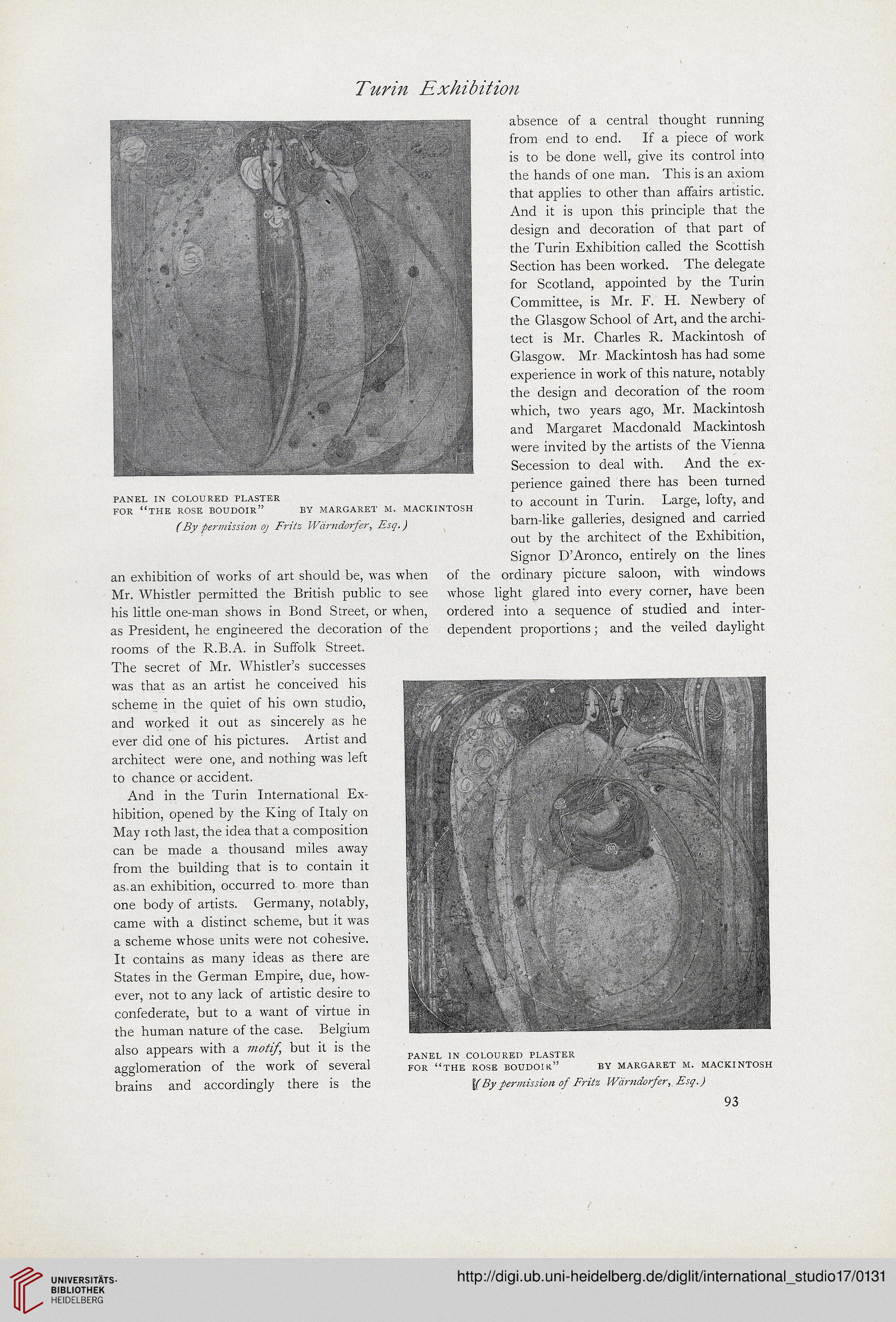Turin Exhibition
PANEL IN COLOURED PLASTER
FOR “THE ROSE BOUDOIR”
BY MARGARET M. MACKINTOSH
(By permission oj Fritz Wdrndorfer, Esq.)
absence of a central thought running
from end to end. If a piece of work
is to be done wellr give its control into
the hands of one man. This is an axiom
that applies to other than affairs artistic.
And it is upon this principle that the
design and decoration of that part of
the Turin Exhibition called the Scottish
Section has been worked. The delegate
for Scotland, appointed by the Turin
Committee, is Mr. F. H. Newbery of
the Glasgow School of Art, and the archi-
tect is Mr. Charles R. Mackintosh of
Glasgow. Mr Mackintosh has had some
experience in work of this nature, notably
the design and decoration of the room
which, two years ago, Mr. Mackintosh
and Margaret Macdonald Mackintosh
were invited by the artists of the Vienna
Secession to deal with. And the ex-
perience gained there has been turned
to account in Turin. Large, lofty, and
barn-like galleries, designed and carried
out by the architect of the Exhibition,
Signor D’Aronco, entirely on the lines
an exhibition of works of art should be, was when of the ordinary picture saloon, with windows
Mr. Whistler permitted the British public to see whose light glared into every corner, have been
his little one-man shows in Bond Street, or when, ordered into a sequence of studied and inter-
as President, he engineered the decoration of the dependent proportions; and the veiled daylight
rooms of the R.B.A. in Suffolk Street.
The secret of Mr. Whistler’s successes
was that as an artist he conceived his
scheme in the quiet of his own studio,
and worked it out as sincerely as he
ever did one of his pictures. Artist and
architect were one, and nothing was left
to chance or accident.
And in the Turin International Ex-
hibition, opened by the King of Italy on
May roth last, the idea that a composition
can be made a thousand miles away
from the building that is to contain it
as an exhibition, occurred to more than
one body of artists. Germany, notably,
came with a distinct scheme, but it was
a scheme whose units were not cohesive.
It contains as many ideas as there are
States in the German Empire, due, how-
ever, not to any lack of artistic desire to
confederate, but to a want of virtue in
the human nature of the case. Belgium
also appears with a motif, but it is the
r . PANEL IN COLOURED PLASTER
agglomeration of the work of several for “the rose boudoir” by Margaret m. mackintosh
brains and accordingly there is the \(By permission of Fritz Wdrndorfer, Esq.)
93
PANEL IN COLOURED PLASTER
FOR “THE ROSE BOUDOIR”
BY MARGARET M. MACKINTOSH
(By permission oj Fritz Wdrndorfer, Esq.)
absence of a central thought running
from end to end. If a piece of work
is to be done wellr give its control into
the hands of one man. This is an axiom
that applies to other than affairs artistic.
And it is upon this principle that the
design and decoration of that part of
the Turin Exhibition called the Scottish
Section has been worked. The delegate
for Scotland, appointed by the Turin
Committee, is Mr. F. H. Newbery of
the Glasgow School of Art, and the archi-
tect is Mr. Charles R. Mackintosh of
Glasgow. Mr Mackintosh has had some
experience in work of this nature, notably
the design and decoration of the room
which, two years ago, Mr. Mackintosh
and Margaret Macdonald Mackintosh
were invited by the artists of the Vienna
Secession to deal with. And the ex-
perience gained there has been turned
to account in Turin. Large, lofty, and
barn-like galleries, designed and carried
out by the architect of the Exhibition,
Signor D’Aronco, entirely on the lines
an exhibition of works of art should be, was when of the ordinary picture saloon, with windows
Mr. Whistler permitted the British public to see whose light glared into every corner, have been
his little one-man shows in Bond Street, or when, ordered into a sequence of studied and inter-
as President, he engineered the decoration of the dependent proportions; and the veiled daylight
rooms of the R.B.A. in Suffolk Street.
The secret of Mr. Whistler’s successes
was that as an artist he conceived his
scheme in the quiet of his own studio,
and worked it out as sincerely as he
ever did one of his pictures. Artist and
architect were one, and nothing was left
to chance or accident.
And in the Turin International Ex-
hibition, opened by the King of Italy on
May roth last, the idea that a composition
can be made a thousand miles away
from the building that is to contain it
as an exhibition, occurred to more than
one body of artists. Germany, notably,
came with a distinct scheme, but it was
a scheme whose units were not cohesive.
It contains as many ideas as there are
States in the German Empire, due, how-
ever, not to any lack of artistic desire to
confederate, but to a want of virtue in
the human nature of the case. Belgium
also appears with a motif, but it is the
r . PANEL IN COLOURED PLASTER
agglomeration of the work of several for “the rose boudoir” by Margaret m. mackintosh
brains and accordingly there is the \(By permission of Fritz Wdrndorfer, Esq.)
93




